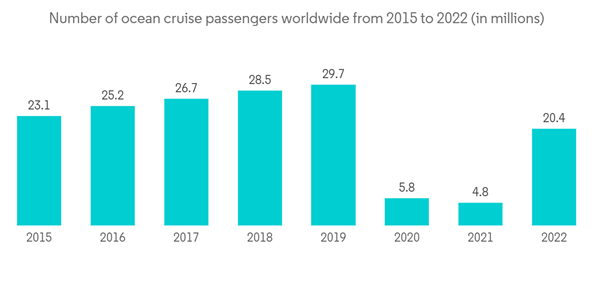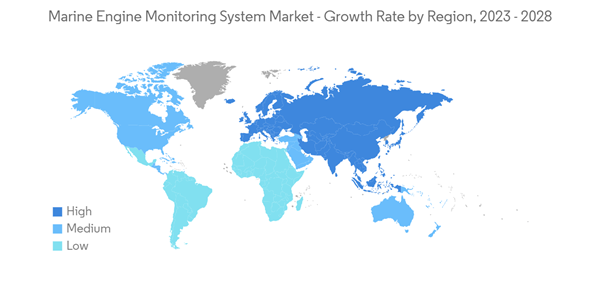Over the long term, the major factors that will drive the market are increasing trade activities between the economies which will increase the demand for marine vessels as the major trade activities between countries take place through the marine route. For instance, in India, 90% of its total international trade by volume takes place through marine routes.
The rise in stringent government norms for the regulation of marine safety and pollution will drive also the growth of the Marine engine monitoring system market. Customization of marine engine monitoring systems for the safety of operations and cost reduction has also been a driving factor for the market study. However, During the forecast period, it is expected that these trade activities are going to rise owing to the trade activities from the developing nations.
The market will also benefit from technological advancements in real-time data tracking in marine engine monitoring systems. Further, the lower expenses associated with manufacturing, installation, and operation have significantly bolstered the adoption of fixed propellers when contrasted with controllable pitch alternatives. However, the market expansion is being hampered by variations in oil and gas costs.
Marine Engine Monitoring System Market Trends
Passenger Type Witnessing Major Growth
Reduction of carbon emission is the focal point for most of the shipbuilders in the current scenario as major shipbuilders are investing in cleaner technologies to achieve the goal of zero emissions from operations. For instance,MSC World Europa, an LNG-powered cruise ship features advanced environmentally-friendly technologies, such as an LNG-powered fuel cell, with a 50-kilowatt demonstrator system that incorporates solid oxide fuel cell (SOFC) technology, as SOFC solution can reduce greenhouse emissions by about 30%. The LNG Cruise ship will be built in France and is set to enter service in 2022.
The Chinese authorities have made emission requirements even stricter than the International Maritime Organization (IMO) regulations. The China GB15097 regulation, which is commonly known as C1 and C2, includes limits for particulate matter (PM). Thus, key players are launching new engines that meet these stringent emission norms, which are further driving the market in the region.
- In September 2022, Wartsila Corporation announced orders for its newly launched Wartsila 20 engines in China. These engines are equipped with Wartsila NOR NOX emissions reducer to comply with China’s stage II, popularly known as C2, emissions standards.
With globalization establishing roots in the core of many economies, there are increasing opportunities for international trade goods to provide a superior selection of accessible items at various price points.
In terms of commercial value, the ranking of fleet ownership and registration is more volatile than in terms of tonnage. China increased its share the most, by 1.1 percentage points, followed by Switzerland, Hong Kong China, and the Republic of Korea, all of which have a higher proportion of container ships in their fleets.
The above-menitoned develpment across the globe is likely to witness major growth for the market during the forecast period.
North America is the Largest Market
Over the recent years, this region has depicted rapid economic development as well as the growth of the manufacturing and energy sectors, thereby accelerating maritime trade, these activities are expected to increase in the forecast period.The rise in seaborne trade has subsequently contributed to a rise in the demand for ships used to transport manufactured goods globally. The region consists of fastest growing economies in the world like China and India. The rapid pace of growth is supported by increasing industrialization and construction activities in the region. This will require an increase in demand for marine vessels for raw materials and finished goods imports and exports from the region. This will drive the growth in the market.
The local government is introducing contracts for ships for the navy, which may generate the demand for defense ships in the country. To support the government’s plans to build a large vessel fleet, the government signed a long-term strategic agreement with two Canadian shipyards, namely, Irving Shipbuilding Inc. (Halifax) and Seaspan’s Vancouver Shipyards Co. Ltd (Vancouver), for the construction of combat and non-combat naval vessels for the Royal Canadian Navy and non-combat vessels for the Canadian Coast Guard.
- In this regard, in January 2023, Irving Shipbuilding and the federal government agreed to a USD 1.6 billion contract to build two additional Arctic and offshore patrol ships for the Canadian Coast Guard.
- In June 2022, The Government of Canada began negotiations with ChantierDavie of Lévis, Quebec, towards an umbrella agreement to become the NSS's third strategic shipbuilding partner.
The conversions of the existing fleet with the new ships are anticipated to lower the emissions from the ships and boost the growth of the marine engine monitoring system market in the country.
Marine Engine Monitoring System Industry Overview
The Marine Engine Monitoring system market is dominated by several key players such as ABB Ltd., Caterpillar Inc., Cummins Inc., Hyundai Heavy Industries Co. Ltd., and others. Companies are investing heavily in research and development for the innovation of new and advanced products and technologies that enable users to monitor their engines for proper preventive and predictive maintenance to reduce the probability of engine downtime. For instance,- In April 2023, DNV introduced Emissions Connect, a data verification engine and data management platform designed to assist the maritime industry in accurately assessing and working with emissions data. The solution provides a reliable, verified source of emissions data that can be securely shared with all stakeholders involved in the maritime value chain.
- In March 2022, ABB Ltd. introduced Tekomar XPERT marine, a comprehensive digital solution that offers shipowners simplified management of propulsion efficiency and emissions reporting.
Additional Benefits:
- The market estimate (ME) sheet in Excel format
- 3 months of analyst support
This product will be delivered within 2 business days.
Table of Contents
Companies Mentioned (Partial List)
A selection of companies mentioned in this report includes, but is not limited to:
- ABB Ltd.
- Cummins Inc.
- Caterpillar Inc.
- Emersion Electric Co.
- Hyundai Electric
- Jason Marine
- Kongsberg
- Krohne marine
- Mitsubishi heavy Industries Ltd.
- Noris Group










